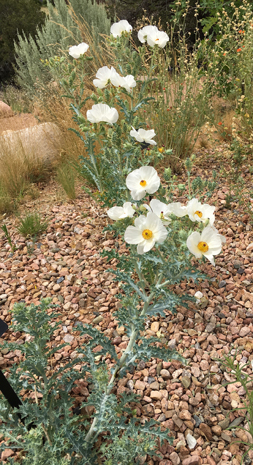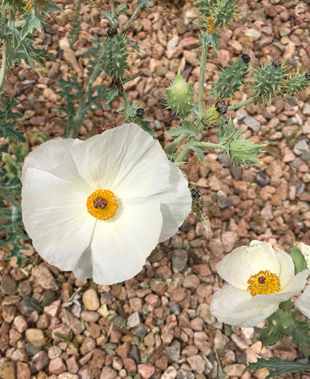(cardo, chicalote)
 |
 |
The plant w/flowers |
Flowers |
Description
"Duration: Perennial Nativity: Native Lifeform: Forb/Herb General: Stems purplish, rather closely to sparingly prickly throughout, 50-120 cm tall. Leaves: Prickly mainly on vein, less so above, essentially smooth between the veins; lower and middle cauline leaves lobed one-half to five-sixths to the midrib, the lobes one to two times as wide, the margin angular at the apex, the sinuses and lobes subequal in width, uppermost leaves either not clasping or subclasping. Flowers: Buds subspherical to obovate; calyx with few to many perpendicular prickles per sepal, the sepal horn 6-10 mm long, flattened or angular in cross-section when fresh, the apical prickle usually flattened and indurated at its base; petals white, stamens 150 or more. Fruits: Ovate to elliptic capsule, sparsely to closely prickly. Ecology: Found on dry gravelly soil, foothills and mountain valleys from 2,500-7,500 ft (762-2286 m); flowers April. Distribution: AZ, NM; south to n MEX. Notes: The primary Argemone in the area and very distinct with its prickles all over, showy white petals and many bright yellow stamens followed by globose fruits which emit a black tar when punctured.Two subspecies found in the region subsp. pleiacantha and subsp. ambigua, subsp. pleiacantha is much more prickly than subsp. ambigua. Ethnobotany: Unknown for this species, but many other uses for species in this genus. Etymology: Argemone from Greek argemos, a white spot (cataract) on the eye, what it was supposed to cure, pleiacantha is from Greek pleios, many, more than one and akantha, thorn." (SEINet)
Ethnobotanical Uses
Medicine:
"Comanche Eye Medicine Sap used for sore eyes. Paiute Burn Dressing and Dermatological Aid Salve of pulverized seeds used on burns, cuts, and sores. Shoshoni --- Cathartic Roasted, mashed seeds taken as powder or pills to serve as a physic." (Moerman 90)
Other Uses:
"Kiowa Unspecified Leaf ash used under the skin for tattooing." (Moerman 474)